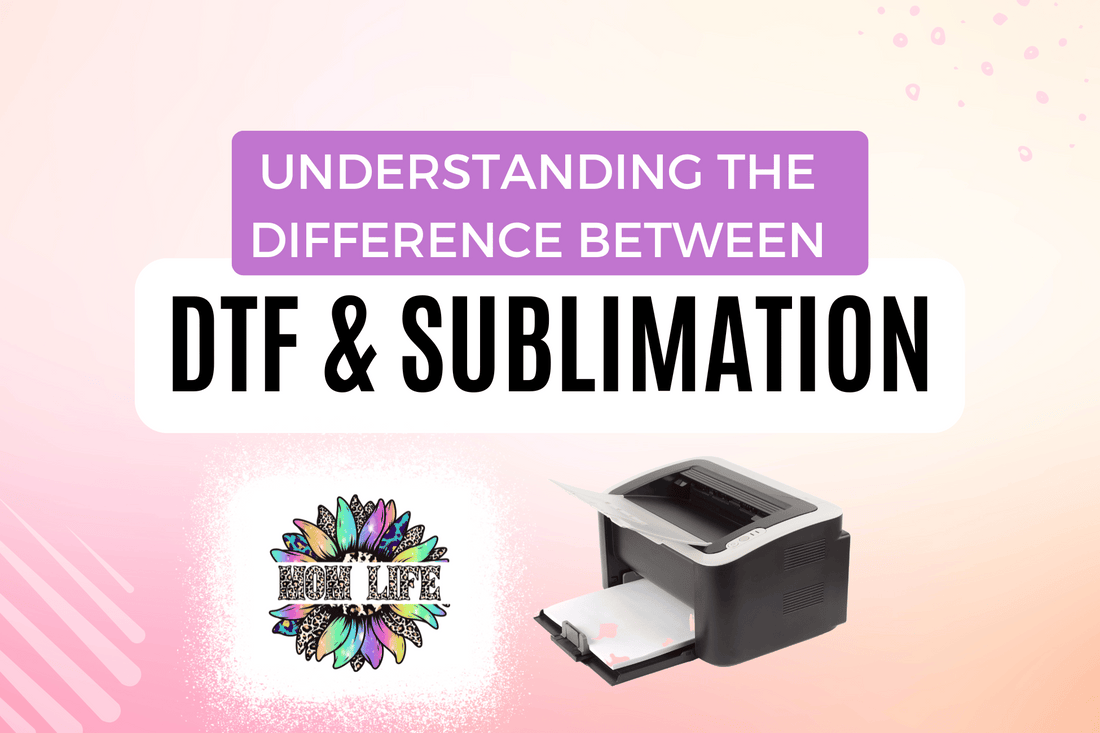Understanding the Difference Between DTF Transfers and Sublimation Transfers: Which is Better and Why?
In the world of custom printing, there are various methods and techniques available to transfer designs onto different surfaces. Two popular methods are DTF (Direct-to-Film) transfers and sublimation transfers. While both techniques are used to achieve high-quality prints, they differ in terms of the process, versatility, and suitability for specific applications. In this blog, we will explore the differences between DTF transfers and sublimation transfers and discuss which method may be better based on various factors.
DTF Transfers:
DTF transfers involve printing the design directly onto a specialized film, which is then heat transferred onto the desired surface. This technique typically utilizes a combination of a DTF printer, special ink, and a heat press. The ink used in DTF transfers contains a white base layer, allowing for vibrant colors on both light and dark fabrics. DTF transfers can be used on a wide range of materials, including cotton, polyester, blends, and even non-textile surfaces such as ceramics or wood.
Advantages of DTF Transfers:
- Versatility: DTF transfers offer versatility by allowing printing on various types of fabrics and non-textile materials.
- Vibrant colors on dark fabrics: The presence of a white base layer in the ink enables vibrant and opaque colors on dark-colored garments or substrates.
- Detailed designs: DTF transfers can reproduce intricate designs with sharp details and high resolution.
- Cost-effective for small runs: DTF transfers are a cost-effective option for small print runs as they do not require minimum order quantities.
Sublimation Transfers:
Sublimation transfers involve printing the design onto a specialized sublimation paper using sublimation ink. The ink is then heat transferred onto a substrate, usually polyester or polyester-coated items. During the heating process, the ink turns into a gas and permeates the substrate, resulting in a permanent and vibrant print.
Advantages of Sublimation Transfers:
- Vibrant and durable prints: Sublimation transfers produce vibrant and long-lasting prints that resist fading, cracking, or peeling.
- Unlimited color options: Sublimation printing allows for unlimited color options and gradients, providing a wide range of design possibilities.
- Seamless designs: Sublimation transfers can cover the entire garment or substrate, allowing for continuous, all-over designs without any visible borders or edges.
- Suitable for polyester-based items: Sublimation transfers are primarily used on polyester or polyester-coated items, making them an ideal choice for sportswear, activewear, and other polyester-rich fabrics.
Which Method is Better?
Determining the "better" method between DTF transfers and sublimation transfers depends on various factors, including the desired outcome, the materials to be printed on, and the specific application.
- Fabric/substrate type: If you plan to print on a wide range of materials, including cotton, blends, or non-textile surfaces, DTF transfers offer greater versatility compared to sublimation transfers, which are primarily suitable for polyester-based items.
- Color requirements: If your design includes vibrant colors and needs to be printed on dark fabrics, DTF transfers with a white base layer provide excellent color reproduction. Sublimation transfers excel in producing vibrant prints on polyester substrates with unlimited color options and gradients.
- Cost considerations: DTF transfers can be a cost-effective choice for small print runs, as they do not require minimum order quantities. Sublimation transfers may be more cost-effective for larger quantities due to the lower cost of sublimation ink and the ability to print multiple items simultaneously.
- Design complexity: If your design includes intricate details, DTF transfers offer sharper resolution and can accurately reproduce fine lines and small text. Sublimation transfers can cover larger areas seamlessly, making them ideal for all-over prints without visible edges.
Both DTF transfers and sublimation transfers have their unique advantages and considerations. The choice between the two methods depends on your specific requirements, such as the type of fabric/substrate, color requirements, budget, and design complexity. DTF transfers are versatile and suitable for various materials, including cotton and non-textile surfaces, while sublimation transfers excel in vibrant prints on polyester-based items. Consider your needs and consult with a printing professional to determine the most suitable method for your project, ensuring the best outcome for your custom printing needs.
Checkout a video of us pressing DTF transfers HERE.

